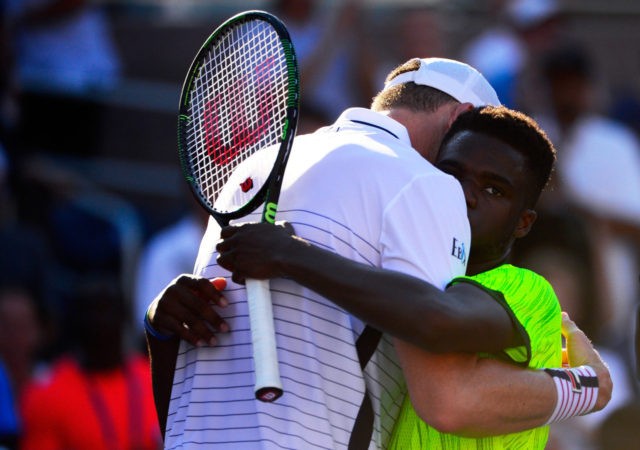NEW YORK CITY—The sheer beauty of the Isner-Tiafoe first round match at the U.S. Open only partly stemmed from their contrasting styles, ages, backgrounds.
Their similarities shined more brightly in the maiden match for men’s singles on the new Grandstand Stadium. He’s a class act, John Isner, 31-year-old Georgian and top man in men’s tennis said of Frances Tiafoe. The 18-year-old Maryland born and bred son of immigrants from Sierra Leone, answered in kind, with a powerful gesture. He fell into his opponent’s chest with what looked like an exhausted sob at the conclusion of a sun-soaked marathon of a five-setter that slipped away from him by scarcely two shots.
That’s tennis, and that’s tennis etiquette: gentlemen and sportsmen, courteous and never-quitters.
The calm cool and collected Isner, who at six-ten looks like the power forward he might have been, held his nerve with the kind of iron hand that probably can only be seen in a veteran. Now, as opposed to the glory days of yore when it was almost common to see teen phenoms such as Boris Becker and Michael Chang burst onto the big stage, tennis players, no matter how gifted – Tiafoe actually broke into the big time two years ago – need years of work to hit the top ranks. For one thing, their elders, such as Isner, due perhaps to better fitness regimens (one can doubt that and remember the kind of regimen the long-playing Pancho Gonzales kept, but let that pass for now), coaching, and the recuperative opportunities made possible by lotsa moolah, not excluding fantastically advanced medical procedures on arms, wrists, knees – they last longer. So they have more time to keep getting better. This, after all, is the reason Serena Williams is still the best on the women’s tour, and her sister Venus arguable the second best, and they are in the mid-30s.
Character matters too, of course. Isner is an inspiration to the younger players; that is why Tiafoe, notwithstanding the visible hurt of losing so close a match—he won the first two sets and was serving at 5-3 in the fifth when the dynamic turned decisively—felt good afterward, thanked the crowd and his opponent for giving him such a chance, and vowed to continue.
There is no reason to believe he won’t. He has progressed on all fronts since the arguably premature launch of his career a couple years ago. His powerful net game, his shrewd service game that, without being anywhere near Isner’s ace-making machine, served him well on critical points, his speed, and particularly the harnessing of his speed (which as a 16-year-old he tended to take for granted, leaving him flat footed on points he could have reached), and his whiplash forehand with the deep top spin.
It was, to put it simply, a sensational match, all three—or four, or five? It felt like a whole day in that packed new stadium, every seat taken, the spectators baking and sweating, holding their breaths, roaring, applauding. It was the best way to kick off the new stadium you could have imagined, and this was after an earlier match, also a kid-almost-beats-veteran beauty, the resilient Taylor Townsend not-quite-making it against the even more resilient Caroline Wozniacki, ex-number one but here unseeded, also felt like a splendid christening for the new grounds (over 8,000 capacity.)
Yes, it works. The U.S. Open always works the wonder of making you feel that this place is moving, changing, jumping, improving. Young kids coming up against wily and brilliant veterans, the (relatively) aging Novak Djokovic demolishing a challenger in his night-time opening round, even as the legendary Phil Collins stepped up to join in the opening ceremonies (alongside such old standbys as … the national anthem.). And Jack Sock, midway between kid and veteran at 23, holding off another fresh-faced Tiafoe-generation teen, California’s Taylor Fritz, in yet another gripping five-setter. Sports keeps manufacturing its future; tennis is no exception. And the managers of the National Tennis Center at Flushing Meadows, Queens, seem to know this better than anyone. It’s always hopping here and even when the hoppin’ looks like deep urban renewal, as it does this year, it’s really always the classic game that stays.
So it’s a half-billion dollars well spent, all these current improvements, of which the new stadium and the fantastic roof over Arthur Ashe (cover or uncover in under ten minutes) are only the most spectacular. The destruction of the beloved old Grandstand (to make way for totally renovated and roofed Louis Armstrong in a year or so) is cause for nostalgic sorrow, and fans will pack in this week to see the last points played on its legendary court. But what, this is Queens, not the Porte d’Auteuil or SW 19. There are reasons, respectable ones, why it may be a large error to change the look and feel and very nature of the grounds at Wimbledon or Roland-Garros. They don’t apply to New York City.
And this, note, is precisely why, too, it was altogether fitting for John Isner to put in his two cents worth on the Colin Kaepernick affair, two cents worth a million bucks. He said it was foolish to denigrate the flag and the national anthem, you can say what you want in this country and that’s why you better remember what keeps it that way.

COMMENTS
Please let us know if you're having issues with commenting.